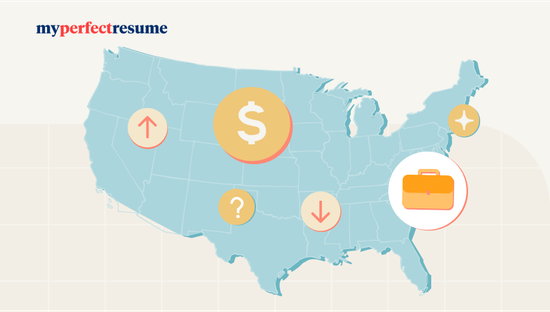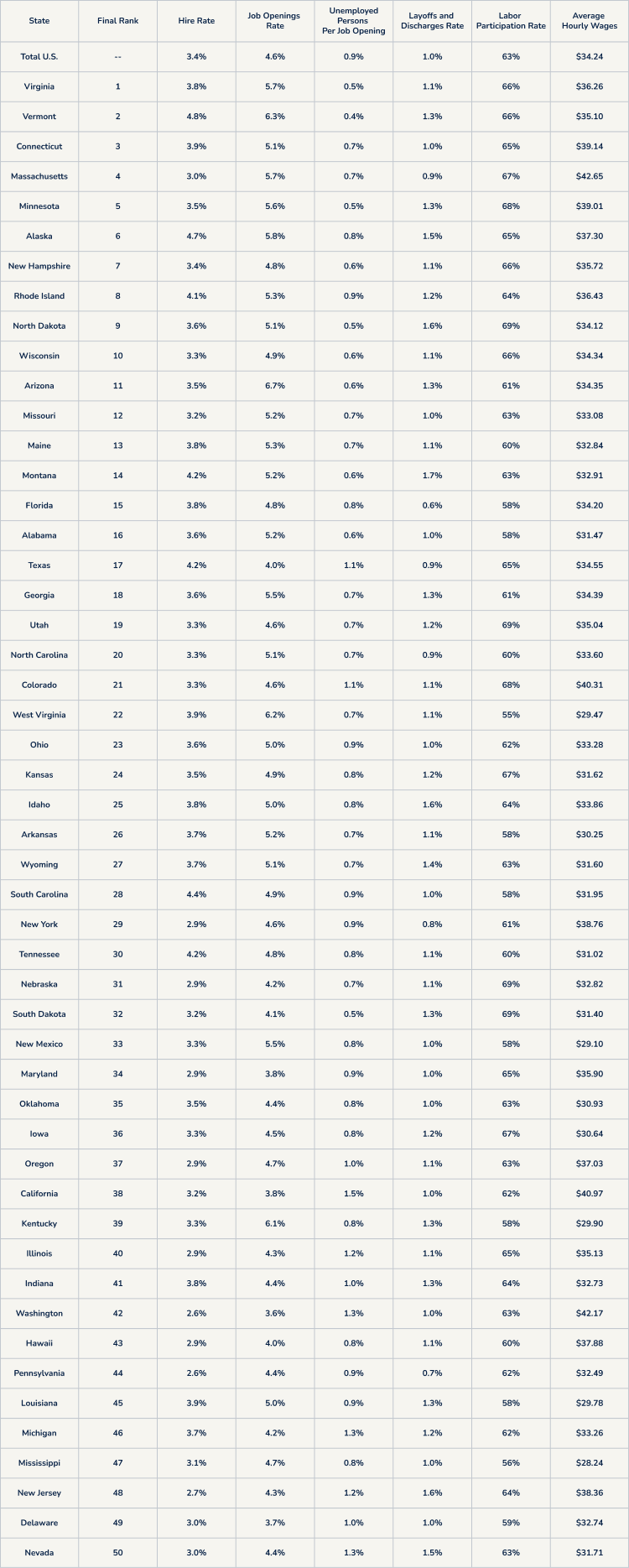Our customers have been hired at: *Foot Note
If you're considering a career move this year, it’s not just what you do that matters—it’s where you do it. Find out where the job market is hottest—and where it’s not.
New research from MyPerfectResume breaks down which U.S. states offer the strongest job markets for 2025 based on the latest data from the Bureau of Labor Statistics.
This year’s State Job Opportunity Rankings analyzes all 50 states using six key labor market indicators, helping job seekers see where their prospects are brightest.
How We Ranked the States
To determine job market strength, states were evaluated across six labor indicators:
- Hire rate: The percentage of hires relative to total employment
- Job openings rate: How many jobs are available compared to the size of the workforce
- Unemployed persons per job opening: Better odds for applicants due to fewer unemployed people per job opening
- Layoffs and discharges rate: Lower rates as an indicator of job security
- Labor force participation rate: A sign of how many working-age people are active in the labor market
- Average hourly wages: Higher wages as an indicator of better compensation and cost-of-living alignment
Each state received a composite score based on its performance across all six factors.
Top 10 States for Job Seekers in 2025
Here’s where the job outlook is strongest this year:
- Virginia: High job openings (5.7%), low unemployment competition (0.5 per opening), and strong wages ($36.26)
- Vermont: Leads in hire rate (4.8%) and job openings (6.3%)—excellent availability for job seekers
- Connecticut: Ranks high in job stability and boasts strong wages ($39.14)
- Massachusetts: #1 in average hourly wages ($42.65) and top five for job stability
- Minnesota: Low job competition and the third-highest labor participation rate (68.1%)
- Alaska: Strong job creation with high hiring (4.7%) and openings (5.8%) rate
- New Hampshire: Balanced across the board with high wages and low unemployment
- Rhode Island: Solid job openings, stability, and compensation despite its size
- North Dakota: The highest labor participation rate in the country (69.4%)
- Wisconsin: Low unemployment per job and stable workforce participation
Full State-by-State Job Opportunity Rankings
We've compiled a comprehensive table showcasing key labor market indicators for all 50 states, providing a more detailed perspective of the best states for jobs.
This data offers insights into each state's job market dynamics, including hiring and job opening rates, the number of unemployed persons per job opening, the rate of layoffs and discharges, workforce participation, and average hourly wages.
The table below presents the following metrics for each state:
Surprising Trends in the Data
Small Northeastern states are winning
Five of the top 10 states—Vermont, Rhode Island, Connecticut, New Hampshire, and Massachusetts—are clustered in the Northeast.
Their success is driven by stable public-sector employment and economies that are heavily invested in healthcare and education.
Alaska and North Dakota overdeliver
Although often overlooked, both states have notable job availability per capita and high workforce engagement, particularly in energy, transportation, and healthcare.
West Virginia climbs the ranks
At #22, West Virginia surprised many. Growth in remote work and infrastructure investment may be reshaping its labor market potential.
Trouble for Nevada and New Jersey
Despite major job hubs like Las Vegas and Newark, both states rank in the bottom three due to high layoffs, low hiring, and stagnant job openings.
Sunbelt & Mountain West states hold strong
Texas, Florida, Georgia, Utah, Colorado, Arizona, and others continue to be strong performers, driven by population growth and booming tech sectors.
Bottom 5 States for Job Opportunities
Not every state is thriving. These five are facing uphill battles in 2025:
- #50 Nevada: Struggles with high layoffs and weak job creation
- #49 Delaware: Low job openings and more applicants per job
- #48 New Jersey: Low hiring and openings relative to workforce size
- #47 Mississippi: Lagging in wages, participation, and job security
- #46 Michigan: High layoffs and low labor engagement
Whether you're actively job hunting, navigating job loss, or simply considering a change, understanding where opportunities are most abundant can give you a significant edge.
While economic conditions remain uncertain, states like Virginia, Vermont, and Connecticut are safe bets for workers seeking strong hiring, stability, and competitive pay.
On the other hand, if you live in or are considering relocating to states like Nevada or New Jersey, proceed with caution. Consider broadening your skill development and job search strategies to stay competitive.
For example, learn how to create an ATS-friendly resume that passes applicant tracking systems (ATS) and stands out to employers in your field.
Ultimately, this ranking highlights a crucial truth: your location can significantly influence your career trajectory. As industries shift and labor markets evolve, keeping a close eye on regional trends can help you make more informed decisions in 2025 and beyond.
For press inquiries, please contact Nathan Barber at nathan.barber@bold.com
Methodology
To determine the best states for job opportunities in 2025, MyPerfectResume analyzed the most recent data from the Bureau of Labor Statistics (BLS) as of January 2025. Each of the 50 U.S. states was evaluated across six key labor market indicators:
- Hire rate: The percentage of total employment represented by new hires
- Job openings rate: The proportion of job openings relative to total employment
- Unemployed persons per job opening: The relationship between a lower ratio and a favorable job seeker market
- Layoffs and discharges rate: Reflects job stability and market volatility
- Labor force participation rate: Measures the share of the working-age population actively engaged in the labor force
- Average hourly wages: Indicates earning potential and cost-of-living competitiveness
Each metric was ranked across all 50 states and normalized to create a composite score. States with more vigorous hiring activity, higher job availability, lower unemployment competition, better job stability, higher workforce participation, and stronger wages scored better. Explore productivity by state for additional insights into state-by-state and regional labor trends.
Our customers have been hired at:*Foot Note




